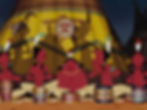Native Americans and film: from stereotypes to progress
- Mel Rising Dawn Cordeiro, Assistant Opinions
- Nov 6, 2023
- 2 min read
Mel Rising Dawn Cordeiro
Editor-in-Chief
The portrayal of Native Americans in movies has a long and often problematic history. For decades, Hollywood has shaped the image of Indigenous peoples through a lens that frequently perpetuated stereotypes, misrepresented cultures and overlooked the complexity of Native American identities. However, recent years have seen a shift toward more accurate and respectful depictions, thanks to increased awareness and collaboration with Indigenous communities. Let’s explore the evolution of Native American representation in cinema and the ongoing efforts to promote authenticity and diversity in film.
Historically, Native American characters in film were often one-dimensional stereotypes, reinforcing harmful clichés. These stereotypes included the stereotypes of the "noble savage," the "savage warrior" and the "drunken Indian." These portrayals reduced Indigenous people to simplistic caricatures, ignoring the rich diversity of cultures, languages and traditions among Native American tribes.

One of the most iconic examples of this misrepresentation is the character of Tonto in "The Lone Ranger." Tonto, portrayed by non-Native actor Johnny Depp, perpetuated the "faithful sidekick" trope, reducing a potentially complex character to a caricature.
The 1970s marked a turning point in Native American representation in film. Indigenous activists and artists, including the American Indian Movement, began to demand more accurate and respectful portrayals. This activism led to the production of films like "Little Big Man" (1970) and "Dances with Wolves" (1990), which featured Native American actors in significant roles and depicted their cultures and struggles more realistically. "Smoke Signals" (1998), directed by Chris Eyre and based on a screenplay by Sherman Alexie, was another milestone. The film offered an authentic portrayal of contemporary Native American life, humor and relationships, challenging preconceived notions of what Native American cinema could be.
In recent years, there has been a growing emphasis on casting Indigenous actors in Native American roles and involving Indigenous communities in the filmmaking process. Films like "The Revenant" (2015) and "Wind River" (2017) made strides in this direction by featuring Indigenous actors and highlighting contemporary issues facing Native communities.
Furthermore, Indigenous filmmakers have emerged as a force in the industry. Directors like Taika Waititi and Sterlin Harjo have gained recognition for their work that celebrates Indigenous cultures, challenging the traditional Hollywood narrative.
Despite the progress made, there are still challenges to overcome. Casting non-Native actors in Native American roles remains an issue, as does the perpetuation of harmful stereotypes in some mainstream films. Additionally, cultural appropriation remains a concern, as seen in instances like the controversy surrounding the film "Aloha."
The portrayal of Native Americans in movies has come a long way from the days of harmful stereotypes and misrepresentation. There is still work to be done but the increasing involvement of Indigenous voices in film, both in front of and behind the camera, offers hope for a more authentic and diverse representation of Native American cultures and experiences. As viewers and consumers of media, it is crucial to support films that prioritize authenticity and to continue demanding fair and respectful representation in Hollywood. By doing so, we can help ensure that the legacy of misrepresentation becomes a thing of the past.



